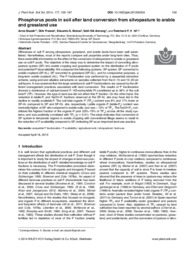Phosphorus pools in soil after land conversion from silvopasture to arable and grassland use.
Phosphorus pools in soil after land conversion from silvopasture to arable and grassland use.
Author(s): SLAZAK, A.; FREESE, D.; MATOS, E. da S.; NII-ANNANG, N.; HÜTTL, R. F.
Summary: Differences in soil P among silvopasture, grassland, and arable lands have been well established. Nevertheless, most of the reports compare soil properties under long-term sites. Thus, there exists little information on the effect of the conversion of silvopasture to arable or grassland use on soil P pools. The objective of the study was to determine the impact of converting silvopasture system (SP) into arable cropping and grassland system on the distribution of P pools and potential P bioavailability. We compared the following systems: SP system, SP converted to arable cropland (SP-AL), SP converted to grassland (SP-GL), and for comparative purposes, a long-term arable cropland (AL). The P fractionation was performed by a sequential extraction scheme, using acid and alkaline extractants on samples collected from the 0?10 and 10?20 cm soil layers. It was assumed that the large variations in soil-P fractionations are caused by the different management practices associated with land conversion. The results of P fractionation showed a dominance of calcium-bound P, HCl-extractable Pi constituted up to 36% of the soil total P (TP). However, the type of land use did not affect this P fraction. On the other hand, the reduction in labile-Pi and NaOH-Pi fractions observed at the SP-AL site may have led to the decline in readily available P. The soil total organic P (TPo) content was 8% and 17% lower at SP-AL compared to SP and SP-GL site, respectively. Labile organic-P (labile-Po) content was markedly higher at SP site compared to arable soils, and was ≈ 10% of TPo. The NaOH-Po constituted the highest fraction of the organic-P pool (55%?79% of TPo) across all the study systems, and was positively correlated with TPo (p < 0.01). The study indicates that conversion of SP system in temperate regions to arable cropping with conventional tillage seems to result in the reduction of P availability compared to SP, indicating SP as an important land-use practice.
Publication year: 2014
Types of publication: Journal article
Observation
Some of Embrapa's publications are published as ePub files. To read them, use or download one of the following free software options to your computer or mobile device. Android: Google Play Books; IOS: iBooks; Windows and Linux: Calibre.
Access other publications
Access the Agricultural Research Database (BDPA) to consult Embrapa's full library collection and records.
Visit Embrapa Bookstore to purchase books and other publications sold by Embrapa.

